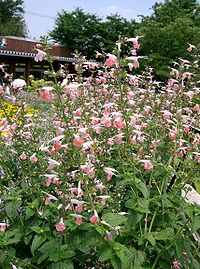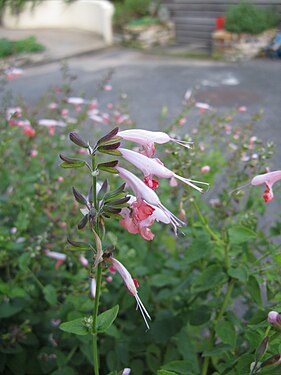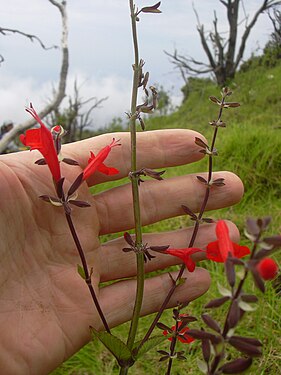Difference between revisions of "Salvia coccinea"
| (3 intermediate revisions by one other user not shown) | |||
| Line 1: | Line 1: | ||
{{SPlantbox | {{SPlantbox | ||
|familia=Lamiaceae | |familia=Lamiaceae | ||
| − | |genus=Salvia | + | |genus=Salvia |
|species=coccinea | |species=coccinea | ||
|common_name=Texas sage, Tropical sage | |common_name=Texas sage, Tropical sage | ||
|name_ref=Flora - A Gardener's Encyclopedia | |name_ref=Flora - A Gardener's Encyclopedia | ||
| + | |habit=shrub | ||
| + | |habit_ref=Flora - A Gardener's Encyclopedia | ||
|Max ht box=40 | |Max ht box=40 | ||
|Max ht metric=in | |Max ht metric=in | ||
| Line 13: | Line 15: | ||
|Max wd metric=in | |Max wd metric=in | ||
|width_ref=Flora - A Gardener's Encyclopedia | |width_ref=Flora - A Gardener's Encyclopedia | ||
| + | |lifespan=perennial | ||
|exposure=sun | |exposure=sun | ||
|sun_ref=Flora - A Gardener's Encyclopedia | |sun_ref=Flora - A Gardener's Encyclopedia | ||
| + | |features=flowers, hummingbirds | ||
|flowers=red, pink, white | |flowers=red, pink, white | ||
| + | |Min Temp Num=20 | ||
|Temp Metric=°F | |Temp Metric=°F | ||
| + | |temp_ref=Wikipedia | ||
|min_zone=9 | |min_zone=9 | ||
|usda_ref=Flora - A Gardener's Encyclopedia | |usda_ref=Flora - A Gardener's Encyclopedia | ||
|max_zone=12 | |max_zone=12 | ||
| − | |image= | + | |image=Salvia coccinea1.jpg |
| − | + | |image_width=200 | |
| − | |||
| − | |||
| − | |||
| − | |||
| − | |||
| − | |||
| − | |||
| − | |||
| − | |||
| − | |||
| − | |||
| − | |||
| − | |||
| − | |||
| − | |||
| − | |||
| − | |||
| − | |||
| − | |||
| − | | image_width = | ||
| − | |||
| − | |||
| − | |||
| − | |||
| − | |||
| − | |||
| − | |||
| − | |||
| − | |||
| − | |||
}} | }} | ||
| + | '''''Salvia coccinea''''', commonly known as '''Texas sage''', '''scarlet sage''', '''tropical sage''', or '''blood sage''', is a species of [[flowering plant]] in the [[Mentha|mint]] family, [[Lamiaceae]]. It is native to the [[Southeastern United States]], [[Mexico]], [[Central America]], the [[Caribbean]], and northern [[Southern America]] ([[Colombia]], [[Peru]], and [[Brazil]]), but is widely cultivated as an [[Ornamental plant|ornamental]].<ref name="GRIN"/> Its [[specific name]], coccinea, means "scarlet-dyed" in [[Latin]], referring to its [[flower]]s.<ref>A Dictionary of Common Wildflowers of Texas & the Southern Great Plains isbn 9780875653099</ref> They are tubular, bright red, about {{convert|1.25|in|cm|abbr=on}} long<ref>East Gulf Coastal Plain Wildflowers isbn 9780762727186}}</ref> and [[Pollination|pollinated]] by [[hummingbird]]s and [[Butterfly|butterflies]].<ref name="Floridata">http://www.floridata.com/ref/S/salv_coc.cfm</ref> | ||
| + | |||
| + | In the garden, the species is considered frost-tender and usually grown as an [[Annual plant|annual]]. In frost-free climates, flowers may be produced as early as February and continue through December. In other areas, flowering begins as days lengthen and continue until first frost in fall. While considered frost tender, light freezes will merely kill foliage, it takes a freeze below 20 degrees F. to kill them roots and all. | ||
| + | |||
| + | Plants grow best with plenty of sun and rich, well-drained [[soil]]s. | ||
| + | |||
| + | Hummingbirds appear to favor this species over ''Salvia greggii'', the autumn sage. | ||
| + | |||
{{Inc| | {{Inc| | ||
| − | |||
Salvia coccinea, Linn. (S. rosea, Vahl). Annual or sometimes perennial and subshrubby: st. herbaceous, erect, 1-2 ft. high, canescent-pubescent: lvs. petiolate, 1-2 in. long, ovate, acute, crenate, base cordate, pubescent above, hoary-tomentose beneath; floral lvs. ovate, acuminate, deciduous: racemes simple; floral whorls remote, 6-10-fld.; calyx tubular-campanulate, striate, often purplish, the teeth acute; corolla scarlet, glabrous. July. S. C. to Fla. and Texas, Mex., W. Indies, Trop. Amer., and cult. and occasionally escaped in India and Austral.—Probably all of the material grown as this is not true to name, possibly the larger part of it is in reality S. splendens. Var. bicolor, Hort., has the upper lip white, the lower lip brilliant carmine-red. Var. lactea, Hort., has white fls. Var. major, Regel (S. filamentosa, Tausch. S. Roemeriana, Hort., not Scheele), becomes a subshrub up to 4 1/2 ft. high, is apt to be less canescent-pubescent and has larger bright scarlet-red fls. June to late autumn. Gt. 7:232. Var. nana, Hort., is a dwarf much-branched form. Var. nana carminea, Hort., is offered in the trade. Var. nana compacta, Hort., is a dwarfer and more bushy form than the variety proper. | Salvia coccinea, Linn. (S. rosea, Vahl). Annual or sometimes perennial and subshrubby: st. herbaceous, erect, 1-2 ft. high, canescent-pubescent: lvs. petiolate, 1-2 in. long, ovate, acute, crenate, base cordate, pubescent above, hoary-tomentose beneath; floral lvs. ovate, acuminate, deciduous: racemes simple; floral whorls remote, 6-10-fld.; calyx tubular-campanulate, striate, often purplish, the teeth acute; corolla scarlet, glabrous. July. S. C. to Fla. and Texas, Mex., W. Indies, Trop. Amer., and cult. and occasionally escaped in India and Austral.—Probably all of the material grown as this is not true to name, possibly the larger part of it is in reality S. splendens. Var. bicolor, Hort., has the upper lip white, the lower lip brilliant carmine-red. Var. lactea, Hort., has white fls. Var. major, Regel (S. filamentosa, Tausch. S. Roemeriana, Hort., not Scheele), becomes a subshrub up to 4 1/2 ft. high, is apt to be less canescent-pubescent and has larger bright scarlet-red fls. June to late autumn. Gt. 7:232. Var. nana, Hort., is a dwarf much-branched form. Var. nana carminea, Hort., is offered in the trade. Var. nana compacta, Hort., is a dwarfer and more bushy form than the variety proper. | ||
| − | Var. pseudo-coccinea, Gray (S. pseudo-coccinea, Jacq.), grows 2-4 ft. high, and has the st., petioles, and often the margins of the floral lvs. conspicuously beset with hirsute hairs. Mex. and Cent. Amer | + | Var. pseudo-coccinea, Gray (S. pseudo-coccinea, Jacq.), grows 2-4 ft. high, and has the st., petioles, and often the margins of the floral lvs. conspicuously beset with hirsute hairs. Mex. and Cent. Amer. Var. punicea, Hort. (S. coccinea var. splendens, Hort. S. superba, Hort.), differs from the type in being larger, slenderer and later-flowering and in having fls. of a brighter red, more velvety and more closely placed. Var. punicea nana, Hort., differs from the variety proper in being dwarfer and the twigs more branched. Var. rosea nana, Hort., is offered in the trade. Var. splendens, Hort., equals var. punicea, Hort. |
{{SCH}} | {{SCH}} | ||
}} | }} | ||
==Cultivation== | ==Cultivation== | ||
| − | + | ||
===Propagation=== | ===Propagation=== | ||
| − | + | ||
===Pests and diseases=== | ===Pests and diseases=== | ||
| − | |||
| − | == | + | |
| − | + | ==Varieties== | |
| + | A wide selection of [[cultivar]]s are available, including 'Lady in Red' (densely packed [[Raceme|spikes]] of scarlet flowers with whitish [[bract]]s), 'Coral Nymph' (bicolored salmon pink and white flowers), and 'Snow Nymph' (white flowers). | ||
==Gallery== | ==Gallery== | ||
| − | |||
| − | <gallery> | + | <gallery perrow=5> |
| − | + | File:Texas sage (1571020768).jpg | |
| − | + | File:Salvia coccinea2.jpg | |
| − | + | File:Starr 041229-2784 Salvia coccinea.jpg | |
| + | File:Starr 040327-0009 Salvia coccinea.jpg | ||
</gallery> | </gallery> | ||
==References== | ==References== | ||
| + | <references/> | ||
*[[Standard Cyclopedia of Horticulture]], by L. H. Bailey, MacMillan Co., 1963 | *[[Standard Cyclopedia of Horticulture]], by L. H. Bailey, MacMillan Co., 1963 | ||
<!--- xxxxx *Flora: The Gardener's Bible, by Sean Hogan. Global Book Publishing, 2003. ISBN 0881925381 --> | <!--- xxxxx *Flora: The Gardener's Bible, by Sean Hogan. Global Book Publishing, 2003. ISBN 0881925381 --> | ||
| Line 92: | Line 76: | ||
{{stub}} | {{stub}} | ||
| − | + | __NOTOC__ | |
| − | |||
| − | |||
Latest revision as of 08:08, 10 May 2010
| Habit | shrub
| |
|---|---|---|
| Height: | ⇕ | 40 in"in" can not be assigned to a declared number type with value 40. |
| Width: | ⇔ | 20 in"in" can not be assigned to a declared number type with value 20. to 32 in"in" can not be assigned to a declared number type with value 32. |
| Lifespan: | ⌛ | perennial |
| Exposure: | ☼ | sun |
|---|---|---|
| Features: | ✓ | flowers, hummingbirds |
| Minimum Temp: | ☃ | 20°F266.483 K <br />-6.667 °C <br />479.67 °R <br /> |
| USDA Zones: | 9 to 12 | |
| Flower features: | ❀ | red, pink, white |
|
Salvia > |
coccinea > |
Salvia coccinea, commonly known as Texas sage, scarlet sage, tropical sage, or blood sage, is a species of flowering plant in the mint family, Lamiaceae. It is native to the Southeastern United States, Mexico, Central America, the Caribbean, and northern Southern America (Colombia, Peru, and Brazil), but is widely cultivated as an ornamental.[1] Its specific name, coccinea, means "scarlet-dyed" in Latin, referring to its flowers.[2] They are tubular, bright red, about 1.25 in cm long[3] and pollinated by hummingbirds and butterflies.[4]
In the garden, the species is considered frost-tender and usually grown as an annual. In frost-free climates, flowers may be produced as early as February and continue through December. In other areas, flowering begins as days lengthen and continue until first frost in fall. While considered frost tender, light freezes will merely kill foliage, it takes a freeze below 20 degrees F. to kill them roots and all.
Plants grow best with plenty of sun and rich, well-drained soils.
Hummingbirds appear to favor this species over Salvia greggii, the autumn sage.
Read about Salvia coccinea in the Standard Cyclopedia of Horticulture
|
|---|
|
Salvia coccinea, Linn. (S. rosea, Vahl). Annual or sometimes perennial and subshrubby: st. herbaceous, erect, 1-2 ft. high, canescent-pubescent: lvs. petiolate, 1-2 in. long, ovate, acute, crenate, base cordate, pubescent above, hoary-tomentose beneath; floral lvs. ovate, acuminate, deciduous: racemes simple; floral whorls remote, 6-10-fld.; calyx tubular-campanulate, striate, often purplish, the teeth acute; corolla scarlet, glabrous. July. S. C. to Fla. and Texas, Mex., W. Indies, Trop. Amer., and cult. and occasionally escaped in India and Austral.—Probably all of the material grown as this is not true to name, possibly the larger part of it is in reality S. splendens. Var. bicolor, Hort., has the upper lip white, the lower lip brilliant carmine-red. Var. lactea, Hort., has white fls. Var. major, Regel (S. filamentosa, Tausch. S. Roemeriana, Hort., not Scheele), becomes a subshrub up to 4 1/2 ft. high, is apt to be less canescent-pubescent and has larger bright scarlet-red fls. June to late autumn. Gt. 7:232. Var. nana, Hort., is a dwarf much-branched form. Var. nana carminea, Hort., is offered in the trade. Var. nana compacta, Hort., is a dwarfer and more bushy form than the variety proper. Var. pseudo-coccinea, Gray (S. pseudo-coccinea, Jacq.), grows 2-4 ft. high, and has the st., petioles, and often the margins of the floral lvs. conspicuously beset with hirsute hairs. Mex. and Cent. Amer. Var. punicea, Hort. (S. coccinea var. splendens, Hort. S. superba, Hort.), differs from the type in being larger, slenderer and later-flowering and in having fls. of a brighter red, more velvety and more closely placed. Var. punicea nana, Hort., differs from the variety proper in being dwarfer and the twigs more branched. Var. rosea nana, Hort., is offered in the trade. Var. splendens, Hort., equals var. punicea, Hort. CH
|
Cultivation
Propagation
Pests and diseases
Varieties
A wide selection of cultivars are available, including 'Lady in Red' (densely packed spikes of scarlet flowers with whitish bracts), 'Coral Nymph' (bicolored salmon pink and white flowers), and 'Snow Nymph' (white flowers).
Gallery
References
- ↑ Cite error: Invalid
<ref>tag; no text was provided for refs namedGRIN - ↑ A Dictionary of Common Wildflowers of Texas & the Southern Great Plains isbn 9780875653099
- ↑ East Gulf Coastal Plain Wildflowers isbn 9780762727186}}
- ↑ http://www.floridata.com/ref/S/salv_coc.cfm
- Standard Cyclopedia of Horticulture, by L. H. Bailey, MacMillan Co., 1963
External links
- w:Salvia coccinea. Some of the material on this page may be from Wikipedia, under the Creative Commons license.
- Salvia coccinea QR Code (Size 50, 100, 200, 500)




